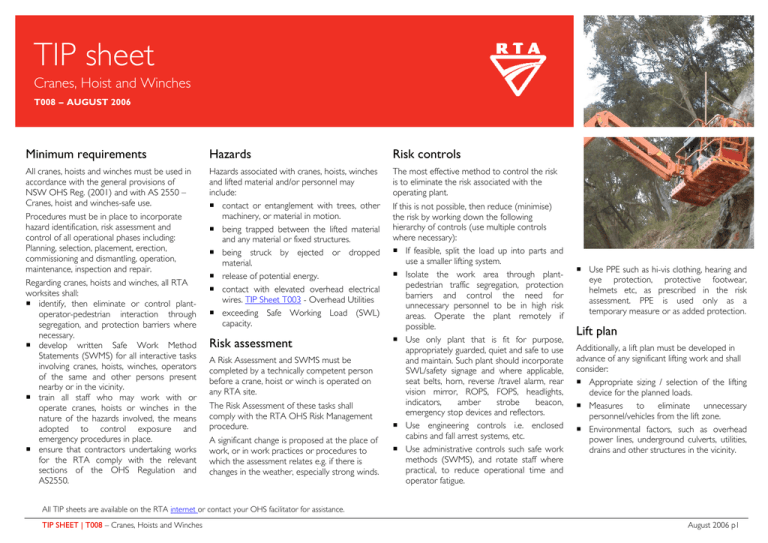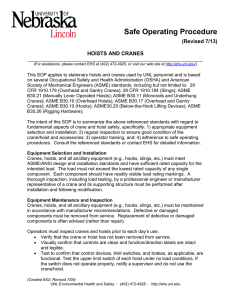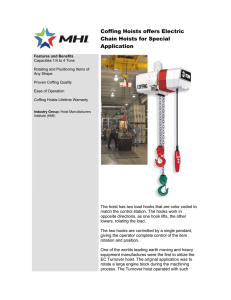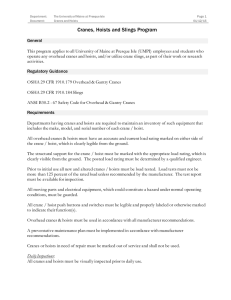T008 Cranes Hoist and Winches Tip Sheet
advertisement

TIP sheet Cranes, Hoist and Winches T008 - AUGUST 2006 Minimum requirements Hazards Risk controls All cranes, hoists and winches must be used in accordance with the general provisions of NSW OHS Reg. (2001) and with AS 2550 – Cranes, hoist and winches-safe use. Hazards associated with cranes, hoists, winches and lifted material and/or personnel may include: contact or entanglement with trees, other machinery, or material in motion. being trapped between the lifted material and any material or fixed structures. being struck by ejected or dropped material. release of potential energy. contact with elevated overhead electrical wires. TIP Sheet T003 - Overhead Utilities exceeding Safe Working Load (SWL) capacity. The most effective method to control the risk is to eliminate the risk associated with the operating plant. Procedures must be in place to incorporate hazard identification, risk assessment and control of all operational phases including: Planning, selection, placement, erection, commissioning and dismantling, operation, maintenance, inspection and repair. Regarding cranes, hoists and winches, all RTA worksites shall: identify, then eliminate or control plantoperator-pedestrian interaction through segregation, and protection barriers where necessary. develop written Safe Work Method Statements (SWMS) for all interactive tasks involving cranes, hoists, winches, operators of the same and other persons present nearby or in the vicinity. train all staff who may work with or operate cranes, hoists or winches in the nature of the hazards involved, the means adopted to control exposure and emergency procedures in place. ensure that contractors undertaking works for the RTA comply with the relevant sections of the OHS Regulation and AS2550. Risk assessment A Risk Assessment and SWMS must be completed by a technically competent person before a crane, hoist or winch is operated on any RTA site. The Risk Assessment of these tasks shall comply with the RTA OHS Risk Management procedure. A significant change is proposed at the place of work, or in work practices or procedures to which the assessment relates e.g. if there is changes in the weather, especially strong winds. If this is not possible, then reduce (minimise) the risk by working down the following hierarchy of controls (use multiple controls where necessary): If feasible, split the load up into parts and use a smaller lifting system. Isolate the work area through plantpedestrian traffic segregation, protection barriers and control the need for unnecessary personnel to be in high risk areas. Operate the plant remotely if possible. Use only plant that is fit for purpose, appropriately guarded, quiet and safe to use and maintain. Such plant should incorporate SWL/safety signage and where applicable, seat belts, horn, reverse /travel alarm, rear vision mirror, ROPS, FOPS, headlights, indicators, amber strobe beacon, emergency stop devices and reflectors. Use engineering controls i.e. enclosed cabins and fall arrest systems, etc. Use administrative controls such safe work methods (SWMS), and rotate staff where practical, to reduce operational time and operator fatigue. Use PPE such as hi-vis clothing, hearing and eye protection, protective footwear, helmets etc, as prescribed in the risk assessment. PPE is used only as a temporary measure or as added protection. Lift plan Additionally, a lift plan must be developed in advance of any significant lifting work and shall consider: Appropriate sizing / selection of the lifting device for the planned loads. Measures to eliminate unnecessary personnel/vehicles from the lift zone. Environmental factors, such as overhead power lines, underground culverts, utilities, drains and other structures in the vicinity. All TIP sheets are available on the RTA internet or contact your OHS facilitator for assistance. TIP SHEET | T008 – Cranes, Hoists and Winches August 2006 p1 Training and certification All crane and hoist operators must hold a current certificate of competency. Certification includes the following: RTA Training course ‘Working with Construction Plant’. Supervised operations recorded in RTA log book. Issue of RTA Plant Safety Certificate or/and issue of relevant WorkCover Certificate. Specific crane, hoist or winch national competency certification. Certificate reassessment shall be no less than at 2 year intervals. Lifting Equipment Slings SWL tags shall be attached on all slings. All slings shall be dry before use: nylon slings lose 10% of its strength when wet. Synthetic slings shall be inspected for cuts, abrasions, or other damage. Wire slings are inspected for kinks, broken wire(s), signs of fatigue, crushing, wear or stretching. Chain Slings are identified as follows: mild steel chain sling - stamped L. high tensile chain sling - stamped P. higher tensile chain slings - branded T, 8, 80, 100, A, 800, PUB or CM and HA800. unmarked chains or chains with marks other than those listed shall not be used. Chain slings shall be inspected for: bent links in a chain. stretching of chain links or fittings. damaged links in chain such as cracks, gouges, nicks, abrasion/wear). deep rust to chain and fittings. cracks or wear to chain and fittings. Shackles SWL must be stamped on all shackles. Shackles must be inspected for bends or fatigue cracks in the body or pin. Cranes All cranes shall have rating plates, load charts and boom angle indicators that are clearly visible from the operator’s position. Loads shall be centred wherever possible. Mobile cranes shall be on firm, level ground with outriggers deployed where provided before the lift commences. Hand signals compliant with AS 2550 shall be utilised during crane operations. Always ‘test lift’ the load slightly to survey the load balance, lowering and resetting slings where necessary. Lock and tag crane controls when not in use. Hoists Power Source – ensure that the lead from the power source is secured well clear of the ground and is in good order. Signs – the ‘Safe Working Load (SWL)’ and the ‘No Person Riding’ signs are in place and easy to read. Inspect cables, sheaves, slings, chains, hooks and eyes, etc. Warning lights/signals – should be in working order. Outriggers are used if needed. For construction more than the equivalent of 3 floors in height, all materials hoists (cantilevered platform and tower) must have warning lights (2 red, 1 green) and a bell system. Do not move the platform when the red lights are showing. (There are two red lights so that if one fuses one will still show. If only one red light is showing arrange for maintenance). Bell signals – = stop. = hoist up = lower. Platform Barrier – check that the attachment points for the barriers are not damaged. Brakes – pre test the brakes to check that they are in working order. Overhead guard should be in place to protect the driver. Security – check that nothing has been touched from the night before. Safe Working Load – all hoist drivers must know how to calculate the safe working load (SWL) of flexible steel wire rope (FSWR). Platform – before unlocking the landing gate, check the position of the platform. Always test run – raise and lower platform to check brakes. Barriers – check for debris or obstructions on hoist. Inspections Environment – consider weather conditions e.g. the effects of wind and water, appropriate lighting and reduce noise. All lifting equipment, slings, shackles etc. shall be inspected prior to every use by a competent and qualified person. e.g. Rigger, Crane Chaser, Dogman, etc. Hoist Wire – check the hoist wire for defects and that the hoist wire is lying neatly on the drum. Ensure that there are no obstructions to the running of wire over or between the winch drum and the foot diversion sheave. Before use of Cranes, Hoists or Winches Inspections of lifting equipment should be recorded for verification. Check that equipment is firmly supported. Power lines de-energised, or at safe distance (> 3 metres for up to 132kV). All equipment properly lubricated and maintained. Signal men positioned appropriately. Reporting of Incidents All incidents are to be reported to the OHS Helpdesk on 1300 131 469. If the incident presents an immediate threat to life or major damage to plant and equipment as advised by the OHS Helpdesk, then: the incident must be reported to WorkCover (by the OHS Helpdesk). the incident may be classified a non disturbance occurrence and advice by WorkCover must be obtained prior to touching the affected site. References NSW OHS Act 2000 and OHS Regulation 2001 Chapters 2, 3, 6 and 8. WorkCover COP – Moving Plant on Construction Sites WorkCover – Hoist Operators Guide AS 1380 – Fibre-rope slings, AS/NZS – 1418 Cranes hoists and winches, AS 2317 – Collared eyebolts, AS/NZS 2550 – Cranes - safe use, AS 2741 – Shackles, AS 3569 – Steel wire ropes. RTA OHS Policy 2.19 – Training and Certification of Construction Plant Operators. All TIP sheets are available on the RTA internet or contact your OHS facilitator for assistance. TIP SHEET | T008 – Cranes, Hoists and Winches August 2006 p2


